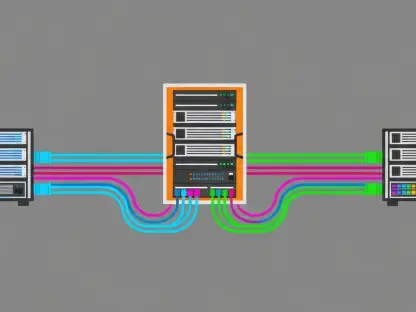The landscape of AI infrastructure is undergoing a seismic shift, with interconnect standards emerging as a critical battleground for dominance in high-performance computing (HPC) and AI development. At the heart of this transformation is Arm’s bold move, announced at SC25, to align with both Nvidia’s proprietary NVLink Fusion ecosystem and the open-standard UALink consortium, raising pressing questions about control, innovation, and the future of AI networking. This roundup gathers diverse opinions and insights from industry leaders, analysts, and stakeholders to unpack Arm’s balancing act, exploring how it reflects broader tensions between proprietary systems and collaborative frameworks in a rapidly evolving field.
Unpacking Arm’s Strategic Maneuvering at SC25
Arm’s announcement at SC25 has sparked intense discussion among industry observers about the implications of straddling two competing ecosystems. Many view this as a pragmatic step to maximize market reach, allowing Arm to tap into Nvidia’s established infrastructure while supporting the emerging potential of open standards. The consensus is that such a strategy positions Arm as a versatile player capable of catering to diverse customer needs in AI and HPC environments.
However, opinions diverge on the long-term viability of this approach. Some industry voices caution that navigating two worlds could lead to fragmented focus, potentially diluting Arm’s influence in either ecosystem. Others argue that this duality is a forward-thinking move, reflecting a trend where flexibility and adaptability are becoming essential for survival in a competitive market dominated by a handful of powerful players.
A key point of interest is how Arm’s involvement might shape customer perceptions. Stakeholders note that offering semi-custom AI solutions through Nvidia’s robust platform provides immediate value, while contributing to UALink’s framework signals a commitment to broader industry collaboration. This dual alignment is seen as a way to hedge against the risks of over-reliance on a single ecosystem, though it remains to be seen how effectively Arm can manage the inherent tensions.
Nvidia’s NVLink Fusion: Control or Collaboration?
Industry Views on Nvidia’s Proprietary Fabric
Nvidia’s NVLink Fusion, introduced earlier this year, has been hailed by some industry leaders as a game-changer for enabling hyperscalers and custom silicon builders to deploy specialized solutions rapidly. The proprietary fabric is praised for its seamless integration with Nvidia GPUs, ensuring high performance and compatibility in AI infrastructure. Supporters argue that this controlled ecosystem offers stability and reliability, critical for large-scale deployments.
Yet, not all perspectives are glowing. Several analysts express concern over the illusion of flexibility, pointing out that while partners like Arm can integrate diverse components, the core interconnect remains firmly under Nvidia’s influence. This structure, they argue, limits true independence and keeps partners tethered to Nvidia’s technological roadmap, raising questions about the balance between collaboration and control.
A recurring theme in discussions is Nvidia’s strategic positioning. Many industry watchers see the proprietary nature of NVLink Fusion as a deliberate move to maintain dominance in AI networking, leveraging over a decade of expertise in fabric technology. This viewpoint suggests that Nvidia’s ecosystem, while innovative, prioritizes its own interests, potentially stifling alternative approaches that could challenge its market grip.
Arm’s Integration: Opportunities and Constraints
Arm’s integration into NVLink Fusion is viewed as a significant opportunity to deliver tailored AI solutions to a wide range of clients. Industry feedback highlights that access to Nvidia’s established platform allows Arm to meet immediate market demands, particularly for hyperscale environments requiring robust interconnects. This partnership is often cited as a practical step for staying competitive in a field where speed and reliability are paramount.
On the flip side, some stakeholders warn of the constraints imposed by Nvidia’s ecosystem. They note that while Arm gains entry into a powerful network, the proprietary nature of the fabric could restrict long-term innovation outside Nvidia’s sphere. This concern underscores a broader debate about whether such alignments enhance or hinder a company’s ability to carve out an independent path.
Another angle of discussion focuses on customer impact. Observers suggest that while Arm’s involvement offers more options for semi-custom designs, it does little to challenge Nvidia’s centrality in the interconnect space. This dynamic, they argue, may limit the diversity of solutions available to end users, even as it provides short-term benefits through streamlined compatibility.
UALink Consortium: A Counterweight to Proprietary Dominance?
Open Standards as a Catalyst for Change
The UALink consortium, with its 1.0 specification released this year and backed by over 80 members including major industry players, is frequently cited as a promising push toward open standards in AI networking. Advocates emphasize its mission to create low-latency, high-bandwidth interconnects free from proprietary constraints, supporting up to 1,024 accelerators. This collaborative vision is seen as a vital counterbalance to dominant ecosystems.
However, skepticism persists about UALink’s ability to disrupt entrenched positions. Some industry voices point out that while the open-standard approach fosters inclusivity, it faces challenges in matching the cohesive, battle-tested frameworks of proprietary systems. Adoption rates vary globally, adding another layer of uncertainty to its long-term impact on the market.
A nuanced perspective emerges around innovation. While open standards are often associated with greater creativity, certain analysts question whether fragmented efforts can deliver the same level of efficiency and reliability as unified, controlled platforms. This debate highlights a critical tension in the industry’s pursuit of scalable, interoperable solutions for AI infrastructure.
Arm’s Role in Shaping Open Collaboration
Arm’s participation in UALink is regarded by many as a strategic endorsement of open collaboration, signaling a commitment to industry-wide progress. Supporters argue that Arm’s involvement lends credibility to the consortium, potentially accelerating the development of interoperable standards that benefit a broader range of stakeholders. This move is seen as aligning with growing demand for flexibility in AI computing pods.
Contrasting views caution against over-optimism. Some industry observers note that UALink’s influence remains nascent compared to established proprietary systems, and Arm’s dual allegiance might dilute its impact within the consortium. There is concern that balancing commitments could lead to slower progress in shaping open standards, especially in a competitive landscape.
An additional point of discussion is the potential for regional disparities. Feedback from global stakeholders suggests that varying levels of readiness for open standards could create uneven adoption, complicating Arm’s efforts to drive consistent change. This dynamic raises questions about how effectively the consortium can unify diverse markets under a single framework.
Hybrid Models: The Future of AI Networking?
Blending Proprietary and Open Systems
The trend toward hybrid models in AI networking, exemplified by Arm’s dual strategy, is gaining traction among industry thought leaders. Many see this approach as a practical response to the specialized demands of HPC and AI, allowing companies to leverage the strengths of both controlled ecosystems and open frameworks. This blending is often described as a way to balance immediate performance needs with long-term scalability.
Differing opinions emerge on the sustainability of such models. While some stakeholders believe hybrid strategies offer a viable path forward, others warn of potential conflicts between proprietary and open priorities. They argue that without clear guidelines, companies risk becoming mired in compatibility issues or strategic misalignments that could hinder progress.
A broader implication discussed is the influence on competitive dynamics. Observers speculate that Arm’s approach might inspire other players to adopt similar dual strategies, potentially reshaping how standards are developed and adopted in AI infrastructure. This shift could lead to a more fragmented yet dynamic market, where adaptability becomes a key differentiator.
Implications for Industry Stakeholders
Insights from various corners of the industry point to hybrid models as a catalyst for rethinking traditional alliances. Some voices advocate for prioritizing compatibility with dominant ecosystems to ensure short-term stability, while simultaneously investing in open standards for future-proofing. This dual focus is seen as a way to navigate the current landscape without sacrificing innovation.
Another perspective emphasizes the role of collaboration in driving hybrid success. Feedback suggests that companies like Arm could play a pivotal role in bridging proprietary and open systems, fostering dialogue that leads to more interoperable solutions. This viewpoint underscores the importance of shared goals in overcoming the inherent challenges of duality.
A final consideration is the impact on end users. Many industry watchers agree that hybrid approaches could ultimately benefit customers by offering greater choice and flexibility in AI infrastructure. However, they stress the need for transparency and clear communication to ensure that the complexities of such strategies do not create confusion or inefficiencies in deployment.
Reflecting on Arm’s Balancing Act and Next Steps
Looking back, the discourse surrounding Arm’s dual alignment at SC25 revealed a complex interplay of control, collaboration, and innovation in AI networking. The roundup of perspectives underscored Nvidia’s strategic grip through NVLink Fusion, while highlighting UALink’s potential as a counterweight through open standards. Arm’s role emerged as a pivotal one, navigating the tension between immediate market demands and long-term industry evolution.
For stakeholders and readers alike, the next steps involve deeper exploration into hybrid interconnect solutions that balance proprietary and open systems. Engaging with both established ecosystems and emerging consortia offers a pathway to address specialized use cases in HPC and AI. Additionally, staying informed about evolving standards and compatibility challenges proves essential for making strategic decisions in this dynamic field.
Beyond individual strategies, fostering industry-wide dialogue stands out as a critical action. Encouraging collaboration between proprietary leaders and open-standard advocates could pave the way for interoperable frameworks that benefit all players. This collective effort holds the promise of shaping a more inclusive and innovative future for AI infrastructure.









